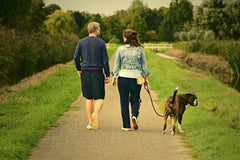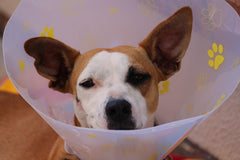
Defense and illustration of French use
By reading the statistics, but also by simply observing the world of cynophilia, we realize that it is the working dogs that are the most appreciated as companion dogs.
Many breeds are named after a function. A profession, you might say. When we say shepherd, herdsman, retriever or greyhound, we imagine a dog at work and selected for an activity, a dog auxiliary to man. The reality is different: few breeds and very few subjects today are subjected to work. The history of dogs tells us that the dog has always been a companion. In the saga The Children of the Earth, the American novelist Jean M. Auel plausibly recounts how the wolf was tamed. She first explains why: it was actually the wolf that came to man's front. It also explains why or for what man accepted it: to make it a pet.
With time, the wolf became a dog. The wolf did not become a guard or hunting dog overnight. It took centuries and centuries for its disposition to be improved by what all breeders do with varying degrees of success: selection.
Selection is as old as breeding, but controlled and official selection is fairly recent: it can be said to date back to the creation of the stud books, a little over a century ago. It was the English who first drew the line by creating the Kennel club in 1873. The French were not far behind: the Société Centrale Canine opened the LOF in 1885.
Before that, everyone did whatever they wanted in their own corner. The Revolution, by abolishing privileges such as hunting, liberated dog breeding. First appeared the bastards: there were very few of them before 1789. Then during the 19th century, a multitude of breeds were born, many of which were used for hunting, of course, but also for guarding, defence, herding, rescue etc.
Success
When it was created, the Société Centrale Canine registered them with a spirit of openness. Its aim is the improvement of breeds in France, but its role has never been to promote or privilege one breed more than another.
If certain breeds are in decline or even degeneration, the SCC does not bear the responsibility. It is the fault of breeders and traders. Both have often but not always been at odds with each other. There are not in France as in Belgium or in some Eastern European countries, dog markets of the same acabit as the markets of farm products. Produced for the best possible profitability, and often in inbreeding, not to try to fix any quality, but because we have the stallion at hand...
We now know, and have known for years, that breeding could not be based on inbreeding on a long-term basis without paying a high price one day. The CCS has not failed to make this known. The demonstration of it was exposed in these columns (Revue de la Cynophilie française n° 177). We also know that the search for hyper-type is accompanied by functional defects that too many pedigree dogs suffer from. It is the breeders who are responsible for the production of the dogs. And also the judges who promote this or that type. Because one can be seduced by the hypertype... Of course, the judges are appointed and partly trained by the SCC, but it is the breed clubs that propose them. You can't blame the CCS for the misdeeds of certain races and the men who drive them.
Conversely, the CCS cannot claim credit for the success of a few others. But we must at least admit that it did not prevent them. It would be unwise to name the races that have failed or are stagnating. On the other hand, we must mention breeds that have succeeded, beyond the use tests for which they were selected.
Today we observe that not all the so-called use breeds are used: trials and competitions even tend to become the speciality of a single breed.
Hunting dogs are undoubtedly an exception: the English Setter dominates but has not crowded out the other breeds of pointing dogs. Its numbers are no longer increasing, but it remains well ahead of group 7. The 567 puppies registered in 2014 are not intended for hunting, far from it. The English Setter remains at this level because it is also very popular as a companion dog.
When it comes to hounds, the beagle has no rivals. Beagle births have doubled in 15 years to reach 4225 in 2014. Because the beagle is the best hound and, selected to be a working dog, it has also proven to be an excellent companion dog in addition to being used in the search for drugs or explosives.
Agility is not yet officially accepted as a test of use, but the success of the discipline is such that its practitioners who want to win and they are numerous, have set their sights on the border collie. Selected in Great Britain and then all over the world on his aptitudes to the herd, the border collie has revealed itself as the best in agility where only a few Malinois or Tervuerens can still worry him.
Maryannic Jourden, president of the working group, has for a long time presented shepherds from the Pyrenees. With regret, but with conviction, she now prefers them the border-collie: "He is an intelligent dog, full of ardour and very fast. We still meet Belgian shepherds, but to gain in agility today, you need a border-collie. She says in the presence of agilitists that she took as a witness: "Everyone agrees. The border-collie imposed itself. There's also Shetland for the smaller sizes."
Agilty, a playful discipline, has emerged as a selection discipline. Agilitists submit their border collies to herd tests so that they can be confirmed and reproduce their agilitist qualities. These border-collies also have a quality well fixed by the selection because they had to be close to their master: they are excellent companions.
Now, the great success of canine dog breeding to date is without a doubt the Belgian Malinois Shepherd Dog.
10306 Belgian shepherds have been registered in 2014, 80% of which are Malinois. The progression of the breed has not been brutal, it owes nothing to a fashion phenomenon, it has been regular since the 1970s.
Why the malinois? If he has come to compete with the German Shepherd and then to surpass him in use, it is because his standard lent itself to it and because the French club of the Belgian Shepherd Dog has always had presidents who have taken care not to compromise the selection of working lines. It cannot be said that François Wasels, president of the club in the 60s and 70s, launched the working Malinois, but it can be said that he gave the users the means to do so.
His successors, more focused on the show dog, never hindered the vocation of the breeders by closing the doors of confirmation. The judges followed the teaching of Pr Bernard Denis who taught his student judges: "Only refuse confirmation to subjects on which you may have a doubt as to his belonging to the breed. "This teaching was relayed in the field by André Varlet, user and canine historian and by Dr. Gilbert Schaffner, user, judge of conformity to the standard and working judge.
Since 1999, it is Marie-France Varlet, canine enthusiast and manager, who has chaired the CFCBB. A small breed club in the 70's, the CFCBB has become a real company which manages both breeding and the organisation of big events without forgetting marketing. André Varlet, Gilbert Schaffner and Marie-France Varlet are at the origin of the creation of a class used in national breeding shows. Lovers of good dogs, they also encouraged users to exhibit their subjects.
The Ring
This being said, if the breed has not stopped thriving, it is thanks to the breeders who have given themselves the objective and consequently the trouble to produce dogs able to practice the most demanding and most criticized discipline there is: the ring. It was Robert Nilo in Le Dressage du chien à la garde et à la défense who first wrote and describes the enthusiasm that one can have for the ring.
He presented in his book almost all the breeds of the 1st group and made known his preference for the flandres bouvier! The book was published in 1946 and one can think that his experience as a trainer dates back to before the war. The trials today are still the same. Many projects of reform of the discipline have been thought, written, imagined. Globoring, a complementary or competing discipline with a global vocation, was launched at the end of the 20th century.
Nothing has changed: the ring remains intangible. The exercises are the same as in the 30's and this French ring continues, without much change. On the other hand, training techniques and the quality of the dogs have evolved. One can even say that they have undergone a revolution. The United States, Mexico, Spain, Morocco and perhaps a few other countries have imported it, with limited success, it must be said. But the other great countries of the dog, Belgium, Germany, the Netherlands did not want our French ring, preferring to keep their national discipline.
It remains that it is indeed the French Ring that has allowed to promote the Malinois, a Belgian breed whose French production is the best. In France, the Belgian shepherd comes to follow the German shepherd that the hegemony of Germany has not ceased to maintain the lead in all countries of the world.
All disciplines taken together, the German Shepherd remains the first breed to be used, not because it is selected for that purpose, except for a few remarkable exceptions such as the breeding of the Legendary Vanova or the Hauts de Hurlevents, but because on such a large production, we always find good and even excellent subjects. For a long time an elite breed, the German Shepherd is today, for the most demanding tests, surpassed by the Malinois.
If the Malinois is so successful, it is not only for the practice of the ring. In fact, only about 10% of the subjects will be subjected to this discipline. The Malinois, selected by or for the ring, is not only good at that. He has also become the dog of the police and armies; patrollers and guards; mountain or rubble rescue workers.
He is also very pleasant in the family, affectionate and even "potty-trained". He is a safe dog in every sense of the word: available when needed, never unpredictable, endowed with good physical and mental health and with an above-average longevity. Thanks to the French ring, selection test of the CCS.
Let's mention the Belgian ring and the Dutch equivalent, which have also given birth to excellent bloodlines from which French breeders have often drawn. But the French Malinois remained closer to the standard. André Noël, a great breeder of Malinois, who was asked why he didn't use such a famous Malinois in Belgium answered: "He is really too ugly...".
André Noël, who was very close at the time of André Varlet, borrowed from Belgian and Dutch breeders, but without ever neglecting the standard. Their friend Léon Destailleurs was less concerned about type and morphology, but he was completely disinterested. André Noël, on the other hand, in addition to his qualities as a breeder, also had qualities of heart and qualities as a trader.
He found a way to sell as companion dogs the females that were not much demanded by the users and was happy about it: "They never bring them back to me...".
It seems that breeders and users of working dogs have one thing in common, a quality that is not very well shared in the world of dog-loving people where one tends to look at one's dogs with Chimène's eyes: they do not lie to themselves. Justin Chastel, a great Belgian breeder of Flandres Cattle Dogs used to say: "When you have chosen a male for your bitch, when you have chosen a puppy in the litter, when you have seen him grow up, and you realize at the age of six months that he is not as you hoped he would be, you don't want to agree...".
Breeders of working dogs have always been clear-sighted and lucid. They have thus produced intelligent dogs that have one essential quality in common: discernment. Courageous at work and cool in the family.
If dogs from working lines, whatever the breed, are today so successful even with those who know nothing about work, it is because they are friendly...
Workers are sometimes called "journeymen". So I end with a proverb of my own: It is among good journeymen that you find the best journeymen...
Jean-Yves Réguer




